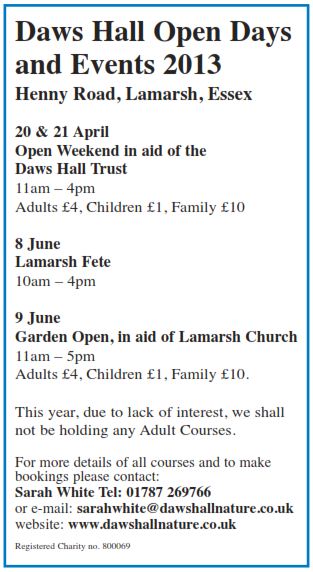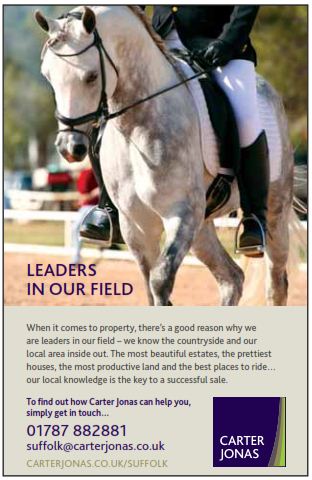GARDEN VISITS
I don’t think Members realised what they might be missing when the details of a visit to Thenford House were given in last year’s Magazine. There were a few vacant seats on the coach, but it was your loss, as the visit was considered a stunning success, by those who went. I am going to quote verbatim the hand out from Thenford, as this was not available, when I set out the details last year. There are 70 acres of arboretum and ornamental gardens. The arboretum has been created since 1977 and contains more than 4000 different species of trees and shrubs. The collection contains rare plants, many of which were wildcollected by well-known plantsmen, including Roy Lancaster, Allen Coombes, Keith Rushforth and Chris Chadwell.
The layout is a horseshoe-shaped ring around the house, and closed by a lake dug in the 1970s. There is a further eighteenth century lake, recently restored, and an ancient yew avenue. There is also a chain of mediaeval stew ponds, which had become silted up but are now clear and running again. The whole of this area clusters around the little church of Saint Mary, which is reflected in the lake. Recent development has included a third lake and a trough garden, which has extended the collections into the realm of numerous alpines.
The old walled kitchen garden was completely rethought in the late 1990s, and the present layout was designed by George Carter. The area, which is approximately two acres, is in four sections – a herb garden, an aviary, a softfruit garden, and a quiet sitting area with a small pool. There are new heated glasshouses. There are kiosks, some containing sculpture reflected in mirror pools. There is a tunnel of wisteria, clematis and rambler roses, and many flower beds. In the centre stands the tall fountain designed by William Pye.

Alongside the house is a new rose garden, again designed by George Carter. The Hornton stone used in the building of the walls and stairs echoes the fabric of Thenford House and the cottages in the village. The centre feature is an old Venetian fountain head, with the missing metalwork newly re-created from an existing Venetian example by James Horrobin.
There is a sculpture garden, which consists of separate “rooms”, displaying contemporary sculpture, mainly by British artists. At either end there is a yew, arcaded circle, with a knot garden within. The Rill is a series of nine formal ponds, each spouting four jets d’eau, which exit under a stone bridge into a series of woodland pools, leading down to the two lakes.

The sculptures were interesting, although I personally found the one of Lenin overpowering, whereas the sculptures of animals were very fine. The walled garden is spectacular, as are the glasshouses within it. The whole layout is unusual and captivating. There is an herbaceous garden along a wall, just outside, which is beautiful. There are many rare trees in the park and more than enough to test one’s knowledge. Several Members managed to speak to Lord Heseltine who charged around in a golf buggy! As the arboretum and gardens are only open to groups four times a year, those of you who did not come, will have to find a group that is going. Good luck!
Garden Visit 2013. Thursday 6th June.
I have, once again, received several ideas, but having taken soundings from some of the “regulars”, I got the impression that a more local visit would be appreciated and I have therefore chosen Blickling Hall in Norfolk, which was recommended by several Members. Members on e-mail will have already received details of this visit. The cost of the 53 seater coach including CSCA purchasing Public Liability Insurance will be £20 per person. Entry to the house and garden is FREE to National Trust Members and at a discounted rate of £9.95 for non-members.
The coach will arrive outside the Eight Bells in Colchester Road, Bures at 09.00 and we will aim to leave at 09.30 which should get us to Blickling just before 12.00 which is when the house opens. Having seen the house we can have lunch in the NT Restaurant and then go round the garden in the afternoon. Depending when everyone gets back to the coach will dictate when we leave to return to Bures. However, we will leave no later than 17.00 which means we should be back in Bures at about 19.00.
Members who are on the internet/e-mail received notification about this visit in February, as it is important to fill the coach, as I personally underwrite the cost. At the time of going to press the coach was over half-full but there are still places and people may drop out. Therefore rather than print a lot of Reservation Forms and send these to all Members I have decided that the best way to deal with others wanting to join the visit is for you to telephone me 01787 227088, (the line sometimes goes dead but you will get through on the second attempt) and find out if there are spaces available, and if there are I will keep you a place and send you a Reservation Form. I will also start a waiting list. Visit the Wickipedia website for Blickling Hall and you can read its full history. However, for those of you without internet this is part of what it says.
History
In the fifteenth century, Blickling Hall was in the possession of Sir John Fastolf of Caister in Norfolk (1380–1459), who made a fortune in the Hundred Years’ War, and whose coat of arms is still on display there. Later, the Hall was in the possession of the Boleyn family, and home to Sir Thomas Boleyn, created Earl of Wiltshire, and his wife, Elizabeth, between 1499 and 1505. It is presumed that their first two children Mary and George were born at Blickling Hall, along with several other Boleyn infants who did not live long. If the couple’s most famous child, Anne Boleyn, was born before 1505 (as one school of historical thought contends) then she, too, was born at Blickling. Other historians maintain that Anne was born after 1505, probably in 1507, and by that time Sir Thomas had moved to Hever Castle in Kent. Nonetheless, a statue and portrait of Anne Boleyn reside in Blickling Hall claiming “Anna Bolena hic nata 1507” (Anne Boleyn born here 1507).
The current Blickling Hall was built on the ruins of the old Boleyn property in the reign of James I, by Sir Henry Hobart, Lord Chief Justice of the Common Pleas and 1st Baronet, who bought Blickling from Robert Clere in 1616. The architect of Hatfield House, Robert Lyminge, is credited with the design of the current structure. The Lord Chief Justice married Dorothy, the daughter of Sir Robert Bell of Beaupre Hall, Outwell/Upwell, Norfolk, Speaker of the House of Commons 1572–1576. A grand display of heraldic material is present throughout the estate.
The Garden
A house and garden existed at Blickling before the estate was purchased by the Boleyn family in the 1450s, but no records survive to give an indication of their appearance. After Sir Henry Hobart acquired the estate in 1616, he remodelled the gardens to include ponds, wilderness and a parterre. A garden mount – an artificial hill in Blickling’s flat landscape, was made to provide views of the new garden. With the accession of Sir John Hobart (later the 1st Earl of Buckingham) in 1698 the garden was expanded to add a new wilderness and the temple was constructed. In the latter half of the 18th century John Hobart, 2nd Earl of Buckingham, embarked on works that would radically change the appearance of the gardens. All traces of formality were removed, and naturally arranged clumps of trees were planted to create a landscape garden. By the 1780s an orangery had been built to overwinter tender citrus trees. Following the 2nd Earl’s death in 1793, his youngest daughter Caroline, Lady Suffield, employed landscape gardener Humphry Repton and his son John Adie to advise on garden matters. John Adie Repton would go on to provide designs for many garden features. The estate was inherited by nine-year-old William Schomberg Robert Kerr, 8th Marquess of Lothian in 1840. He later re-introduced the formality and colour schemes of the parterre. After his death at the age of 38, responsibility for the gardens rested with Lady Lothian and her head gardener Mr Lyon. Philip Henry Kerr, 11th Marquis of Lothian, inherited the estate in 1930. After disparaging comments in a publication of Country Life, Lothian engaged socialite gardener Norah Lindsay to remodel the gardens. In the parterre she replaced the jumble of minuscule flower beds with four large square beds planted with a mixture of herbaceous plants in graduated and harmonious colours. Other improvements included removal of a line of conifers in the Temple walk, which were replaced with plantings of azaleas.
The garden at Blickling contains formal and informal gardens, Grade II listed buildings and structures, woodland, specimen trees,Victorian garden ornaments, topiary, the kitchen garden (open to the public in 2010), and 18th century yew hedges.
The lawns which frame the main approach to the hall are bounded by yew hedges which were first recorded by William Freeman of Hamels in 1745. Surrounding the hall on three sides is the dry Moat. The plantings in the moist, sheltered conditions of the moat were considerably revised by Lindsay who introduced hosta, species of hydrangea, budlea and rosemary. To the rear of the hall is the noted Parterre garden which is located on the east lawn. Originally created as a Victorian sunken garden it was remodelled by Lindsay in the early 1930s. Set around an 18th century listed stone fountain, she divided the garden into four large, colourful herbaceous beds surrounded by L shaped borders stocked with roses and catmint with an acorn shaped yew marking each corner. In the terraces above the parterre there are plantings of peony. Seasonal beds and the Double Borders, created in 2006, contain a wide variety of perennials, shrubs and grasses with colours ranging from hot to cool. Close by, are the White and Black Borders which were established in 2009, together with a collection of elaeagnus. The western side of the garden features the lawned Acre which is fringed by a spreading oriental plane tree. Outdoor sports such as croquet are played here in the summer months. Further highlights are a collection of magnolia underplanted with autumn cyclamen, the shell ountain and the kitchen garden. To the north of the parterre is the Wilderness garden which is bisected by radial grassed avenues flanked with turkey oak, lime and beech trees and naturalised bulbs. The wilderness hides a Secret Garden with a summerhouse, scented plants and a central sundial. Nearby is the listed 18th century orangery which houses a collection of citrus trees. Adjacent to the building is the steep-sided Dell which is home to many woodland plants including a selection of hellebore and foxglove. In 2009, an area of woodland was cleared close to the orangery to create a new garden, stocked with a wide range of woodland plants, including camellia and varieties of mahonia. Opened in 2010, it will be known as the Orangery Garden. The Grade II listed Temple is approached by the Temple walk which is lined with azalea planted by Lindsay in her original 1930s design. Scattered throughout the garden are many garden ornaments including thirty pieces supplied to Lady Lothian in 1877 by Austin & Seeley of Euston Road, London.

Garden Visit 2014
An advance “recce” has been carried out, and one of the gardens that was on the list for 2013 is a must for 2014. It is Waterperry Gardens between Oxford and Aylesbury just off the M40. Members who want to find out more, and who are on the internet, should Google Waterperry. Details of the visit will be in the 2014 Magazine but will be sent to Members with email in the early part of next year.
Mark Dawson

